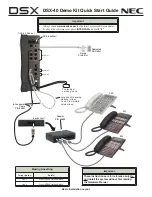
COMPONENT DESCRIPTIONS
10-29
Edition One
XC1000 Service
J43
J44
J45
J46
J47
J48
J49
J50
S2
S1
OR SMT
CONNECTORS
DATA-COMM
PORTS (X..25)
SCCS
INTERFACE
PRIMARY SMT
CABINET 2
TEST POINTS
CABINET 1
TEST POINTS
DISK-BAY
ALARMS
LOGIC-BAY
FAN ALARMS
DIP SWITCHES
J26, J27 TO MONITOR CARD
J28, J29 TO CPU
J31, J32 TO SPARE SLOTS
J25 TO RDAC
AND EXTERNAL
ALARMS
CABINET 2 ALARMS
DATA LINK
Figure 10-16. Connections on the Main Distribution Board.
J31 and J32 connect to the spare card slots, in case logic cards are
installed in the spare slots or are moved to the spare slots. J33 through
J42 are not currently used.
Switch one located at S1 on the distribution board must be set to ON for
systems configured with standby redundancy. The remaining switches
should be set to OFF. For systems that do not have standby redundancy,
set all the switches at S1 to OFF.
The system hardware configuration is set by 10 dip switches located at S2
on the distribution board. These switches indicate to the monitor card
which alarm status lines are active and should be monitored. The switches
are set at the factory and do not need to be changed unless the system is
reconfigured later. Table 10-9 provides a description of each hardware-
configuration switch. An ON setting on the S2 switch indicates that the
switch is disabled.
The monitor card must be reset and restarted after the hardware configuration
is changed. When the system power is turned on again and the system is re-
booted, the monitor card is automatically updated.
Voltage test points for +5 Vdc and +12 Vdc are located in the lower right
portion of the distribution board. Refer to Figure 10-16 for the exact location.
The test points are TP1 (return), TP2 (+5 Vdc), and TP3 (+12 Vdc).
A second set of test points is located at the lower middle of the board, for a
second XC1000 cabinet, if installed. These test points are labeled TP6
(return), TP7 (+5 Vdc), and TP8 (+12 Vdc).
SECTION 10.6
Summary of Contents for XC1000
Page 1: ...EDITION ONE XC1000 P N 101 1345 000 SERVICE MANUAL ...
Page 8: ...CONTENTS ...
Page 19: ...1 INTRODUCTION ...
Page 30: ...2 SITE PREPARATION ...
Page 60: ...3 PLATFORM INSTALLATION ...
Page 112: ...4 STARTUP AND INITIALIZATION ...
Page 177: ...5 ROUTINE MAINTENANCE ...
Page 195: ...6 TROUBLESHOOTING ...
Page 237: ...7 STATUS LOG ...
Page 297: ...STATUS LOG 7 54 Edition One XC1000 Service ...
Page 302: ...8 REPAIR AND REPLACEMENT ...
Page 380: ...9 SYSTEM UTILITIES ...
Page 424: ...10 COMPONENT DESCRIPTIONS ...
Page 465: ...11 OPTIONAL FEATURES ...
Page 485: ...12 RELEASE 1 55 UPGRADE INSTRUCTIONS ...
Page 516: ...13 RELEASE 2 X UPGRADE INSTRUCTIONS ...
Page 559: ...14 RELEASE 3 02 FCP CONVERSION INSTRUCTIONS ...
Page 603: ...15 RELEASE 3 02 ONLINE UPGRADE INSTRUCTIONS ...
Page 631: ...16 RELEASE 3 0 SYSTEM UTILITIES ...
Page 683: ...17 RELEASE 4 X FCP CONVERSION INSTRUCTIONS r P N 281 0023 002 1 of 3 ...
Page 725: ...18 RELEASE 4 X ONLINE UPGRADE INSTRUCTIONS r P N 281 0023 002 2 of 3 ...
Page 760: ...19 RELEASE 4 0 SYSTEM UTILITIES P N 281 0023 002 Part 3 of 3 r ...
Page 776: ...20 RELEASE 4 1 SYSTEM UTILITIES P N 281 0033 000 ...
Page 787: ...APPENDIXES ...
















































